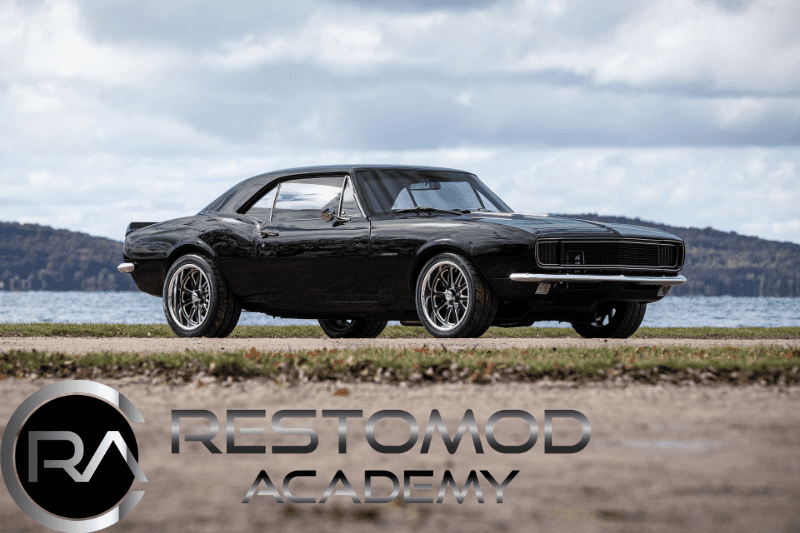- The 1967 Camaro was the inaugural model, released on September 26, 1966. Several major options were unavailable at the time of the introduction. The RPO-Z28 Special Performance Package and the Camaro SS’s 396-cid displacement engine were among them.
- The 1967 Camaro was the only first-generation car with front-mounted rear shocks. So, staggering layouts were designed which prevented wheel hops. The 1967 Camaro was the only one with a right-side traction bar to help with wheel hop. All Z28 vehicles came with a traction bar as standard equipment, and it was optional on other high-performance variants.
- Side marker lights were not available on the 1967 Camaros.
- Only the 1967 Camaro has its VIN tag positioned on the door hinge pillar. Later models moved these IDs to windshield-viewable areas.
- The SS package included the bumblebee nose stripe from the start of 1967 manufacturing, but it became a distinct option (RPO-D91) in March 1968.
Continued – Facts about the 1967 Chevrolet Camaro
- For the 1967 Indianapolis 500, Chevrolet created three unique Camaro pace cars. It also manufactured 78 lookalikes for race officials and dignitaries to use for free during the month leading up to the race. These replicas were sold to the public – used automobiles after the race. All of the cars were white SS/RS convertibles with bespoke bright blue interiors. Other alternatives were diverse. On their doors were emblems that read “Chevrolet Camaro Official Pace Car 51st Annual Indianapolis 500 Mile Race – May 30, 1967.” (Chevrolet also produced 100-560 Pace Car Replicas for a special “Pacesetter” promotion that ran from May to June, as well as 21 cars for export to Canada.) The exact number of cars is unclear; this is my estimate – Greg McGann)
- The 1967 Camaro SS was released in September 1966 with a 350-cid engine, which was unique at the time. In November 1966, the 396-cid engine became an SS option.
- Despite being identical to the 1968 instrument panel, the 1967 instrument panel was unique to that year. The cushioning did not fold over the corners like the year before. The 1967 instrument panel also lacked side air (Astro Ventilation) vents, with the exception of air-conditioned vehicles.
Facts about the 1967 Chevrolet Camaro
- For the 1967 (and 1968) models, the ignition was located on the dash.
- First Z28s were built on December 29, 1966, and delivery began in January 1967. In faThe Z28 was developed for SCCA Trans-Am racing (Sports Car Club of America). The Z28 met the series’ 305 cubic inch displacement limit by combining a 327-cid Chevrolet block with a 283-cid Chevrolet crankshaft for a 4″ x 3″ stroke that produced 302.3 cubic inches.
- The “Z” in Z28 was originally just another option code, similar to Z23 for the Special Interior Group and Z87 for the Custom Interior. The Z28, on the other hand, had a unique ring to it and became the model’s official moniker. The 1967 Z28s, on the other hand, had no visual identifier other than large racing stripes. The ZZ8 option was not available on convertibles.
Facts about the 1967 Chevrolet Camaro
- The 1967 Camaro had a curb weight of 2,910 pounds for the 6-cylinder coupe, 3,070 pounds for the 8-cylinder coupe, 3,165 pounds for the 6-cylinder convertible, and 3,325 pounds for the 8-cylinder convertible, according to Chevrolet. Add 21 pounds for power windows, 20 pounds for the folding rear seat, 86 pounds for air conditioning, 9 pounds for power brakes, 23 pounds for front disc brakes, 10 pounds for the 250-cid 6-cylinder engine, 39 pounds for the 327-cid V-8 engine, 72 pounds for the 350-cid V-8 engine, 258 pounds for the 396-cid V-8 engine, 9 pounds for power brakes, 23 pounds for front disc brakes, 10 pounds for the 250-cid 6-cylinder engine, 39 pounds for The four-speed manual transmission weighs 7 pounds, the Powerglide 14 pounds, the Turbo Hydra-Matic 56 pounds, the dual exhaust 38 pounds, the power steering 29 pounds, and the heavy-duty battery 15 pounds. An AM radio weighs 8 pounds, an AM-FM radio 9 pounds, and the Rally Sport weighs 17 pounds.
- The 1967 Camaro was the only model with side vent windows.
- The 1967 Camaro’s headlight door covers were electrically actuated. The vacuum-operated model came years later. (We highly recommend Music In Motion for high-end car audio and advanced electronic services.)
- Single-leaf rear springs were standard on all 1967 Camaros.
- The 1967 center console design was unique to that year. In addition, the design of the console-mounted alternative instrument cluster was unique until 1967. The fuel gauge, temperature gauge, oil gauge, ammeter, and clock make up the secondary instrument cluster.
- The first 1967 Camaro constructed in Norwood, Ohio, had a VIN that ended in N100001, whereas the first in Van Nuys, California, had a VIN that ended in L100001.
Frequently Asked Questions
Q: How much did the 1967 Chevrolet Camaro cost when it was first released? A: The base price for the Camaro was $2,466 in 1967.
Q: What was the top speed of the 1967 Chevrolet Camaro? A: The top speed of the Camaro depended on the engine and transmission combination, but it was capable of reaching speeds of up to 140 mph.
Q: How many units of the 1967 Chevrolet Camaro were produced? A: A total of 220,906 units were produced in 1967.
Conclusion
We hope this article has provided valuable insights into the facts about the 1967 Chevrolet Camaro and has given you a deeper appreciation for this iconic vehicle. From its unique styling to impressive performance capabilities, the Camaro has stood the test of time and continues to symbolize American muscle car culture.
Whether you’re a long-time fan of the Camaro or just discovering its history for the first time, it’s clear that this car has left a lasting legacy in the automotive industry. Its impact can still be felt today, with modern versions of the Camaro carrying on the legacy of speed and power established with the original model.
Are you interested in learning more about classic cars and restomodding? Contact Restomod Academy to gain the knowledge and skills you need to restore and modify vintage vehicles. From engine rebuilding to custom fabrication, we will teach you everything you need to know to bring your dream car to life.


